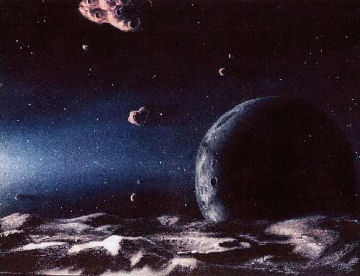A family in space
Astronomers have discovered a "family" of related objects in a distant region of the solar system.
By Emily Sohn
In a distant region of our solar system, scientists have found a group of related objects that have similar surfaces and orbits. It’s the first “family” of objects ever discovered in the Kuiper belt, which is a vast ring of rocky and icy bodies that orbit the sun beyond Neptune.
One member of the family, called 2003 EL61, had already attracted attention because it is so unusual. The icy object is shaped like a squashed football. It is about as wide as Pluto, which is also part of the Kuiper belt. It even has two moons.
 |
|
Someone standing on an object in the Kuiper belt might be able to look up and see a scene like this one.
|
| David Jewitt, University of Hawaii |
The scientists who discovered 2003 EL61 suspected that it had once been involved in a major collision. A big impact would explain why 2003 EL61 spins completely around once every 4 hours, which is very fast. A collision also could have created its two moons. And a crash could explain why the object is so dense. The collision would have knocked most of the ice from its surface, leaving behind a core of heavy rock.
The discovery of 2003 EL61’s family strongly supports the collision theory. That makes it “a milestone in Kuiper belt science and in our understanding of the outer solar system’s development,” says Alessandro Morbidelli of the Observatory of the Côte d’Azur in Nice, France.
Scientists at the California Institute of Technology in Pasadena made the new discovery with the Keck 1 telescope, which sits on Mauna Kea in Hawaii. The observations were part of a survey of 50 Kuiper belt objects.
Now, researchers are puzzling over how to explain the findings. One theory is that the Kuiper belt used to be more crowded than it is now. Crammed together, objects would have crashed into each other more often. But other scientists say that such collisions probably wouldn’t have been strong enough to knock much material off 2003 EL61.
Another theory is that 2003 EL61 and the object that hit it used to be part of a region called the scattered disk, which is also in the outer solar system. Objects in the scattered disk carry lots of energy. They orbit the sun at an angle to the Kuiper belt, but the two regions cross each other in some places.
If objects from different regions crossed paths, a collision could have hurled large chunks of rock and ice into the Kuiper belt, where 2003 EL61 and family now make their home.—E. Sohn
Going Deeper:
Cowen, Ron. 2007. First family: Pluto-size body has siblings. Science News 171 (March 17):164-165. Available at http://www.sciencenews.org/articles/20070317/fob4.asp .
Sohn, Emily. 2007. Defining planethood. Science News for Kids (Feb. 28). Available at http://www.sciencenewsforkids.org/articles/20070228/Feature1.asp .
______. 2007. A dead star’s dusty ring. Science News for Kids (Feb. 21). Available at http://www.sciencenewsforkids.org/articles/20070221/Note2.asp .







